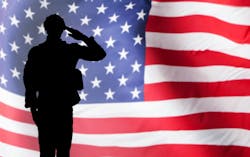Safety Professionals Share Lessons Learned from Their Time in the Military
Every day that you get up and go to your job, you’re doing more than simply working. You are protecting the lives of others.
A commitment to serve and protect is true for workplace safety professionals who want to keep their colleagues safe.It’s also true for those serving with their brothers and sisters in the armed services.
And for those safety professionals who have also donned their military fatigues, Veterans Day is imbued with added importance.
“It’s a day to celebrate all veterans, those who are currently living currently living, currently serving as well as those who are no longer with us," says Scott DeBow, CSP, ARM, principal at Avetta, who served eight years in the U.S. Navy. “It's a day where we somberly reflect on those who have sacrificed for their country because of the oath that they swore to protect against all enemies, foreign and domestic.”
Veterans Day was originally observed on the 11th hour of the 11th day of the 11th month in 1918 to mark the armistice for The Great War. The day has evolved over the decades and, as more wars were fought, Veterans Day has become a federal holiday to honor those who have served in any branch of the United States Armed Forces.
There were more than 18 million living veterans in the United States, about 6% of the nation’s adult population as of November 2023, according to the Pew Research Center. Some of those servicemembers have transitioned into safety roles once they returned to civilian life.
EHS Today spoke with a few individuals who shared their experiences and how their years of service continue to serve them years later as safety professionals. Here are some of the lessons they have learned from the military.
Leadership Skills
Leadership is a learned skill, not an intrinsic birthright, says William D’Amico, global EH&S director for the Victaulic Company, who spent 22 years in the U.S. Navy.
“When I talk to groups, I'll always ask: How many schools could you name, off the top of your head, where you can get an MBA? People can name half a dozen in like 10 seconds. Then I'll ask: How many schools do you know where you essentially are degreed in leadership? It's dead silent.
“Unless you went to one of the four U.S. service academies or the U.S. Merchant Marine Academy, you will not get any formal training on how to lead. Individuals who graduate from those five institutions, immediately upon graduation, have to lead people.”
D’Amico says that employers who hire veterans are automatically hiring someone who has strong leadership skills. That’s because the military instills a sense of discipline, self-confidence and a desire to succeed no matter what the operation is.
Training and Engagement
The military runs drills for many likely and unlikely scenarios. Officers might not use words like OSHA or regulations or compliance, but they are essentially intense training programs.
Ben Andrew, Ed.D, MBA, CSP, environmental, health and safety leader at DuPont, spent nearly a decade in the Navy working on a nuclear aircraft carrier. It was the vary definition of a hazardous workplace: there was aircraft, there was ammunition, there was bombs. He was deployed in parts of the world that saw temperatures of 110 to 125 degrees Fahrenheit.
Andrew found while interviewing for safety jobs as a civilian, he was overqualified for some positions because of his extensive training in the military.
And, even when the hazards are the same, the military offers extra intensity. Take fire drills, for example. Organizations will have evacuation plans and other materials posted throughout the facilities. Employees are taught to have rally or muster points to meet in the event of an evacuation. Organizations run drills a couple of times a year, on average.
Andrew says that civilian employees might not heed the drills or ask when they can get back to work.
“When you come over to the civilian side and recognize they're not taking it that serious, you have got to keep things in context and understand why, because they’re just going to call the fire department,” Andrew says. “In the military, you can be a cook, you can be an administrator, a barber, whatever. You are the fire department. If you have a fire on a Navy vessel, you're talking about the possible sinking of a ship.”
Risk Mitigation
Both the military and civilian employers want to eliminate hazards to make the environment safer for employees, but the way they talk about it is different, DeBow says.
In the military, risk mitigation is the mission. It’s “that doesn’t look safe, so we need to understand the risks from the standpoint of understanding what our risks are and what our controls are,” DeBow says.
“We shouldn’t run away from risk.”
In civilian environments, risks are seen as obstacles or blockers to production, operations, quotas, etc., but they are, in fact, part of the process to make informed decisions and designing solutions that help protect people.
Cultural Awareness
Active duty usually means deployment to other parts of the country—or the world. Travel is one way to see a different way of living, of being able to immerse oneself in another culture, traditions, languages and religions.
While it may not be part of a military service member’s primary mission, learning how to interact with and work in an environment that is different from what they know and are familiar with builds empathy, understanding and awareness.
In the early 2000s, Andrew was stationed in Dubai. Several years later, in civilian life, he learned of shipping delays for goods. Once he realized they were traveling through the Arabian Gulf during Ramadan, the delays made sense.
Andrew says the Navy helped him understand the impacts of global events at a local level and be respectful of those traditions.
“We cherish Thanksgiving,” he says. “But that’s not a thing in other English-speaking countries.”
How to Create a More Welcoming Workplace for Veterans
The transition from military to civilian life is fraught with challenges. Here are ways to make the adjustment easier for yourself or other veterans at your workplace.
Create a veterans support group.
The group need not be exclusive to current and former military personnel, but it should be a space focused on supporting veterans in the workplace.
Andrew says the group may go by different names, such as engagement committees, diversity committee or employee assistance programs. The name itself doesn’t matter, but it should be a safe place for veterans to share.
“Having a committee where they can build community and have a safe space to discuss things is phenomenal,” Andrew says. “This committee should be backed by the executive leadership team. That way, they know their voices are heard.”
Encourage access to external resources.
DeBow serves on the American Society of Safety Professionals (ASSP) board of directors, and he is actively involved in the organization’s Military Practice Specialty.
“ASSP has been an incredible community for me outside of the military,” DeBow says.
Of ASSP’s 35,000 members, there are 794 members in our Military Practice Specialty; the organization also offers discounted membership for active duty military personnel.
Create a more inclusive hiring practice.
Military service will not always translate to or be understood in a civilian environment. Employers need to have folks on staff or work with an outside partner who understands and can explain how rank or responsibilities in the military could transfer in the private sector.
“If you don't know how to do a deep dive on a resume for military candidate, you need to bring someone in with that expertise, because there's a lot of things about the resume of a military person that a nonmilitary individual cannot pick up on,” D’Amico says. “It would be advantageous to either use a recruiting firm that specializes in military or have someone on the staff who can read between the lines on a resume, or at least explain basic things like, what's an E6, O3 or that he was a First Lieutenant on a ship. If you're not used to reading military resumes, you can't get a good picture of the individual you're looking to bring in for an interview.”
About the Author
Nicole Stempak
Nicole Stempak is managing editor of EHS Today and conference content manager of the Safety Leadership Conference.

